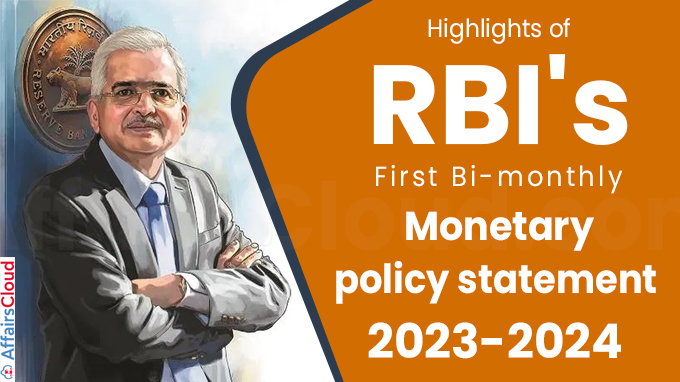 The Reserve Bank of India’s (RBI) 6-members Monetary Policy Committee (MPC) met on 3rd, 5th and 6th of April 2023 and released its first bi-monthly monetary policy statement for FY24 (Financial year 2023-2024).
The Reserve Bank of India’s (RBI) 6-members Monetary Policy Committee (MPC) met on 3rd, 5th and 6th of April 2023 and released its first bi-monthly monetary policy statement for FY24 (Financial year 2023-2024).
Policy Rates:
i.The MPC has decided to keep the policy rates unchanged with the stance remain focused on the withdrawal of accommodation.
ii.The Unchanged Policy rates are as follows:
| Category | Rates |
|---|---|
| Policy Rates | |
| Policy Repo Rate | 6.50% |
| Standing Deposit Facility (SDF) Rate | 6.25% |
| Marginal Standing Facility (MSF) Rate | 6.75% |
| Bank Rate | 6.75% |
| Reverse Repo Rate | 3.35% |
| Reserve Ratios | |
| Cash Reserve Ratio (CRR) | 4.50% |
| Statutory Liquidity Ratio (SLR) | 18% |
Member of MPC:
The MPC meeting was headed by RBI Governor Shaktikanta Das the other 5 members of the committee include,
- Shashanka Bhide, Ashima Goyal, Prof. Jayanth R. Varma, Michael Debabrata Patra, and Dr. Rajiv Ranjan.
a.MPC’s Assessments on growth and inflation:
–Growth
India’s real gross domestic product (GDP) growth for FY24 was projected at 6.5 percent with 7.8 percent in Q1, 6.2 percent in Q2, 6.1 percent in Q3, and 5.9 percent in Q4.
- NSO: The second advance estimate (SAE) released by the National Statistical Office (NSO) on February 28, 2023 placed India’s real gross domestic product (GDP) growth at 7.0% in FY23.
-Inflation
i.Consumer Price Index (CPI) inflation was projected at 5.2 percent in FY24, with 5.1 percent in Q1, 5.4 percent in Q2, 5.3 percent in Q3, and 5.2 percent in Q4.
ii.CPI headline inflation rose from 5.7 percent in December 2022 to 6.4 percent in February 2023 due to higher inflation in cereals, milk and fruits and slower deflation in vegetables prices.
iii.Core inflation (i.e., CPI excluding food and fuel) remained above 6% in January-February 2023.
Note – The Union Government has unchanged the policy rates to achieve the medium-term target for CPI inflation of 4% within a band of +/- 2 percent, while supporting growth.
b.Developmental and Regulatory Policies
-Enhancing Efficiency via PRAVAAH portal:
RBI decided to develop a secured web-based centralised portal named ‘PRAVAAH’ (Platform for Regulatory Application, Validation And AutHorisation)
i.Prevailing condition:
- Different entities are required to obtain license/authorization to carry out activities regulated by RBI, and regulated entities are also required to seek certain approvals under various statutes/regulations periodically.
- Currently, the application and approval processes for the same take place in varied on-line and off-line modes.
ii.Benefit of the Portal PRAVAAH: To overcome the existing difficulty process, RBI developed the PRAVAAH portal. The portal will bring greater efficiencies into regulatory processes and facilitate ease of doing business for the regulated entities of RBI.
- The portal will show time limits for deciding on the applications/approvals sought.
iii.Backdrop: The Union Budget for FY24 has also announced the requirement to simplify, ease and reduce the cost of compliance by financial sector regulators within laid down time limits to decide the applications under various regulations.
iv.RBI stated the further extension of the portal to all types of applications made to it across all functions.
-Onshore Non-deliverable Derivatives Market
i.Backdrop: RBI permitted Banks in India which operate IFSC (International Financial Services Centre) Banking Units (IBUs) to transact in INR (Indian rupee) Non-deliverable derivative contracts (NDCCs) with non-residents and with each other with effect from June 1, 2020.
ii.Now, to develop the onshore INR-NDDC market and to provide residents with the flexibility to efficiently design their hedging programmes, RBI has permitted banks with IBUs to offer INR NDCCs to resident users in the onshore market.
-Centralised Web portal to Search Unclaimed Deposits
i.Prevailing condition:
- Currently, the deposits that are remaining unclaimed for 10 years in a bank are transferred to the ‘Depositor Education and Awareness’ (DEA) Fund which is maintained by the RBI.
- RBI intends to ensure that newer deposits do not turn unclaimed and existing unclaimed deposits are returned to the rightful owners or beneficiaries.
- To return unclaimed deposits, banks display the list of unclaimed deposits on their website.
ii.Web Portal Development: In order to improve the access of depositors/beneficiaries, RBI has decided to develop a centralised web portal for the public to enable search across multiple banks for possible unclaimed deposits based on user inputs. The search results would be enhanced by the use of certain AI (Artificial Intelligence) tools.
-Pre-Sanctioned Credit Lines at Banks through UPI
i.Currently, the Unified Payments Interface (UPI) transactions are enabled between deposit accounts at banks, sometimes intermediated by pre-paid instruments including wallets.
ii.RBI proposed enabling transfer to/from pre-sanctioned credit lines at banks through UPI, i.e. the UPI network will facilitate payments financed by credit from banks.
- The ability to access pre-sanctioned credit lines through UPI will reduce the time and effort required to obtain loans.
Note – UPI handles 75% of the retail digital payments volume in India.
-RBI to Issue New 5-Year Govt Bonds to Raise Rs 8000 Cr
i.RBI decided to auction new 5-year government bonds, which are set to mature in 2028, to raise approximately Rs 8,000 crore in the first bond auction of the FY24 which is scheduled on April 06, 2023.
ii.The Government of India (GoI) also intends to raise up to Rs 33,000 crore by auctioning 3 securities that will mature in 2028, 2033, and 2052.
- Additionally, the GoI can retain additional subscriptions up to Rs 2,000 crore for each security.
c.Additional info on Domestic Economy:
i.Rabi foodgrain production is expected to increase by 6.2 percent in FY23.
ii.In FY23, money supply (M3) expanded by 9.0% and non-food bank credit increased by 15.4 percent.
iii.As on March 31, 2023, India’s foreign exchange reserves were placed at US$ 578.4 billion.
iv.CAD: The current account deficit (CAD) for the first three-quarters of FY23 stood at 2.7 percent of GDP. In Q3 FY23, CAD narrowed significantly to 2.2 percent from 3.7 percent in Q2 FY23.
- As per the statement of RBI Governor, Shaktikanta Das, CAD is expected to remain moderate in Q4 FY23 and in FY24 at a level that is both viable and eminently manageable.
v.Inward gross remittances touched an all-time high of US$ 107.5 billion during calendar year 2022.
Recent Related News:
On January 23, 2023, the Reserve Bank of India (RBI) extended the deadline for banks to complete the process of renewal of agreements for the existing safe deposit locker holders by December 31, 2023 from January 1, 2023.
About Reserve Bank of India (RBI)
Governor – Shaktikanta Das
Deputy Governors – Mahesh Kumar Jain, Michael Debabrata Patra, M. Rajeshwar Rao, T. Rabi Sankar
Establishment – 1st April 1935
Headquarters – Mumbai, Maharashtra




